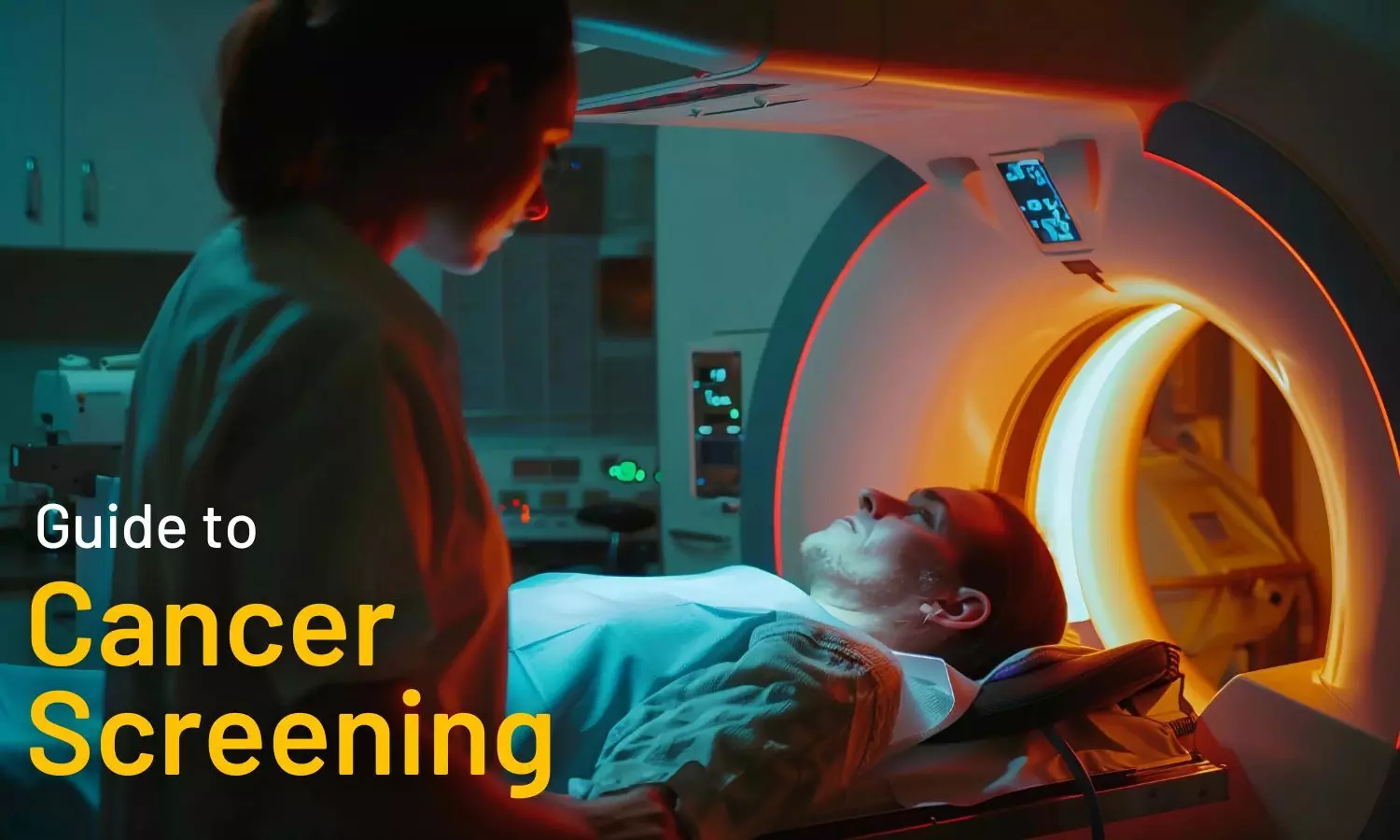National Cancer Awareness Day: A Comprehensive Guide to Cancer Screenings — Which Tests Are Required and When

Learn about the importance of cancer screenings on National Cancer Awareness Day. Discover which tests you need, when to get them, and how early detection can improve survival rates and treatment outcomes.
National Cancer Awareness Day is observed annually in India on November 7. The objective of the day is to raise public awareness of cancer prevention, early detection, and treatment, with an emphasis on reducing the burden of this disease through education. Many forms of cancer can be successfully treated with early detection despite the fact that cancer is one of the primary causes of death worldwide. Recognising the significance of cancer screenings is essential in the battle against this disease. Screening tests have the potential to detect cancer in its earliest stages when it is most treatable.
In this article, we will present an overview of the significance of cancer screenings, the various forms of cancer screenings that are available, and the appropriate time to undergo them. The objective is to enable individuals to take proactive measures for their health, comprehend the importance of early detection, and determine which tests to prioritise based on their age, gender, and risk factors.
What is the Significance of Cancer Screening?
Cancer screenings are medical procedures that are implemented to identify cancer prior to the development of symptoms. It is crucial to conduct routine screenings, particularly for cancers that can develop silently over time, as early-stage cancers are frequently asymptomatic. Cancer is more treatable, and the likelihood of successful treatment increases significantly when detected early. Screening tests assist in the identification of abnormal cells or tumours that may indicate the presence of cancer or could potentially progress to cancer.
The Primary Goal of Cancer Screening Is To:
1. Detect Cancer Early: The diagnosis of numerous malignancies, including breast, cervical, colorectal, and prostate cancer, can be made earlier when treatment is more effective.
2. Reduce Mortality: The probability of successful treatment is significantly increased, and the number of cancer-related fatalities is reduced through early detection.
3. Prevent Cancer: Certain diagnostic tests, such as colonoscopies, can also aid in the prevention of cancer by detecting and removing precancerous growths before their development into malignant tumours.
4. Enhance Quality of Life: The early detection of the condition enables the administration of less aggressive treatment, resulting in a superior quality of life both during and after the treatment.
Cancer Screening Types and Recommended Timing
Variations in cancer screening guidelines are contingent upon personal health, family history, gender, and age. Let us examine the primary forms of cancer screenings and the recommended schedules for each.
1. Screening for Breast Cancer
Breast cancer is among the most prevalent cancers that influence women worldwide. Survival rates can be substantially enhanced through early detection through screening.
Screening tests that are recommended:
Mammogram: A mammogram is an X-ray that examines the breast tissue. It is one of the most effective methods for early detection of breast cancer, frequently occurring prior to the appearance of tumours.
Who is eligible for screening?
It is recommended that women aged 40 and older undergo mammograms every 1-2 years. Women who have a family history of breast cancer or a genetic predisposition (e.g., BRCA mutations) may need to begin screening earlier.
Breast Ultrasound: This test may be recommended for women with dense breast tissue or further investigation following a mammogram.
MRI: In addition to mammograms, women with a BRCA gene mutation, who are at an extremely high risk of breast cancer, may require an MRI.
Self-Examination: It is also advised that all women conduct regular breast self-exams to assist in the identification of changes in the breast tissue. Nevertheless, self-exams should not serve as a substitute for mammograms.
2. Screening for Cervical Cancer
The primary cause of cervical cancer is the persistent infection with specific variants of the human papillomavirus (HPV). Regular screening can assist in the identification of precancerous alterations in the cervix, which can be treated prior to the development of cancer.
Screening tests that are recommended:
Pap Smear (Pap Test): A pap smear is a procedure that entails the removal of cells from the cervix in order to detect abnormal cells. It is effective in the detection of precancerous conditions and early-stage cervical cancer.
Who is eligible for screening?
It is recommended that women commence cervical cancer screening at the age of 21 and maintain it until the age of 65.
It is recommended that women between the ages of 21 and 29 undergo a Pap smear every three years. From the age of 30, women have the option to undergo a combined Pap smear and HPV test every 5 years or to continue with Pap smears every 3 years.
HPV Test: The HPV test is a screening tool that detects high-risk strains of the virus that are associated with cervical cancer. In addition to the Pap smear, women aged 30 and older are typically tested for HPV.
3. Screening for Colorectal Cancer
Colorectal cancer is a significant cause of cancer-related mortality; however, survival rates are high when detected early. Precancerous polyps and early-stage malignancies can be identified through routine screening, which increases the likelihood of successful treatment.
Screening tests that are recommended:
Colonoscopy: This procedure involves the use of a long, flexible tube equipped with a camera to inspect the rectum and colon for any aberrant growth or cancer. It is the preeminent method for the detection of colorectal cancer.
Who is eligible for screening?
The Cancer Society suggests that adults commence colorectal cancer screening at the age of 45. In contrast, individuals with a family history of colorectal cancer or other risk factors may require an earlier start.
How frequently?
If no abnormalities are discovered, a colonoscopy should be performed every decade. Follow-up examinations may be necessary sooner if polyps or other issues are identified.
Faecal Occult Blood Test (FOBT): This test detects concealed blood in the stool, which may serve as an early indicator of colorectal cancer.
Flexible Sigmoidoscopy: This test is administered every five years as an alternative to a full colonoscopy and only examines the lower portion of the colon.
4. Screening for Prostate Cancer
Prostate cancer is among the most prevalent cancers among males. Early detection is essential for improved treatment and outcomes despite the fact that prostate cancer can be slow-growing.
Screening tests that are recommended:
PSA Blood Test: The prostate-specific antigen (PSA) test quantifies the concentration of PSA in the blood, which may be elevated in men with prostate cancer. Nevertheless, elevated PSA levels may also be the result of other conditions, which is why the PSA test is frequently accompanied by additional tests.
Who is eligible for screening?
Beginning at the age of 50, the Cancer Society suggests that men engage in a conversation with their physician regarding prostate cancer screening. Males who are at a higher risk for the condition should initiate the conversation about screening at the age of 45.
How frequently?
PSA testing is typically conducted every 1-2 years; however, the decision to undergo testing should be tailored to the individual's risk factors and preferences.
5. Screening for Lung Cancer
However, lung cancer is treatable when detected early, despite its status as one of the most lethal malignancies worldwide. Screening is especially critical for individuals who are at high risk.
Screening test suggestion:
Low-Dose CT scan (LDCT): A low-dose CT scan is employed to detect lung cancer, particularly in individuals who have a history of excessive smoking.
Who is eligible for screening?
Individuals between the ages of 50 and 80 who have a history of smoking (30 pack-years or more) and are either currently smoking or have ceased within the past 15 years.
How frequently?
High-risk individuals should undergo an annual low-dose CT scan.
6. Screening for Skin Cancer
Skin cancer, particularly melanoma, is one of the most prevalent and preventable cases of cancer. Regular skin examinations can assist in the early detection of suspicious lesions or skin changes.
Screening tests that are recommended:
Skin Exam: A dermatologist can conduct a comprehensive skin examination to detect any abnormal lesions, freckles, or growths that may indicate the presence of skin cancer.
Who is eligible for screening?
It is recommended that individuals with fair skin, a family history of skin cancer, or a history of sunburns endure regular skin checks for those at high risk.
How frequently?
Adults, particularly those with risk factors, should frequently inspect their skin for any changes in moles or spots and undergo a professional skin exam every 1-2 years.
Healthy Lifestyle and Cancer Prevention
Adopting a healthful lifestyle can substantially mitigate your risk of developing cancer, in addition to screenings. The following are a few lifestyle modifications that can assist in the prevention of cancer:
1. Healthy Diet: Consuming a diet that is abundant in fruits, vegetables, and whole cereals while restricting the consumption of processed foods and red meats can reduce the risk of developing cancer.
2. Regular Exercise: Maintaining an active lifestyle can assist in the prevention of numerous malignancies, such as breast and colorectal cancer, and the maintenance of a healthy weight.
3. Reduce Alcohol Consumption and Avoid Tobacco: Numerous malignancies are significantly influenced by excessive alcohol consumption and smoking. By abstaining from these, you can substantially mitigate your risk.
4. Sun Protection: The risk of skin cancer can be reduced by protecting your skin from excessive sun exposure and using sunscreen.
Conclusion
National Cancer Awareness Day is a critical reminder that cancer, despite its severity, can be effectively managed when detected in its early stages. The identification of prospective issues prior to the onset of symptoms is essential for cancer screenings, which greatly contribute to the reduction of mortality rates. Individuals can actively participate in their health and well-being by maintaining awareness of the appropriate screening schedule and procedures.
It is vital to bear in mind that screening tests are indispensable; however, they should be integrated into a comprehensive approach that encompasses a healthy lifestyle and routine visits to your healthcare provider. The fight against cancer could be significantly improved tomorrow by taking these proactive measures today.



















